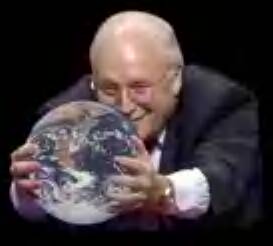His accidental experience of 'an extremely stimulated imagination' caused by the drug led to a lifetime of experiments and initiated the psychedelic generation.
Albert Hofmann, the Swiss chemist who discovered LSD and thereby gave the psychedelic generation the pharmaceutical vehicle to turn on, tune in and drop out, has died. He was 102.
Hofmann died Tuesday morning at his home in Basel, Switzerland, of a heart attack, according to Rick Doblin, the head of MAPS, the Multidisciplinary Assn. for Psychedelic Studies.
Hofmann also identified and synthesized the active ingredients of peyote mushrooms and a Mexican psychoactive plant called ololiuqui and developed at least three related, non-psychoactive compounds that became widely used in medicine.
Those other feats would have been little remembered, however, had he not accidentally gotten a trace amount of an experimental compound called lysergic acid diethylamide on his fingertips and taken the world's first acid trip.
Hofmann was a talented synthetic chemist working in the Basel research center of Sandoz Laboratories -- now Novartis -- in the 1930s when he began studying the chemistry of ergot, the common name for a fungus that grows on rye, barley and certain other plants. Although ergot is poisonous, midwives had used a crude extract for centuries to induce labor in women.
Twenty years earlier, researchers had isolated ergotamine, the first ergot alkaloid isolated in pure form, and the compound had become widely used for halting bleeding after childbirth and as a treatment for migraine headaches.
In the early 1930s, American researchers had identified the primary active ingredient of ergot, a chemical called lysergic acid. Hofmann devised a technique to make a series of derivatives of lysergic acid called amides and began systematically looking for medically useful compounds.
The 25th compound he synthesized, in 1938, was lysergic acid diethylamide (in German, lyserg-saure-diathylamid), or LSD-25. Because this compound had a chemical structure similar to an existing drug called Coramine, Hofmann had hoped that it would be a stimulant for the respiratory and circulatory systems.
But testing in experimental animals showed no significant activity for the drug -- although the animals were observed to become restless after its administration -- and it was abandoned.
During this period, Hofmann synthesized at least three amides that became drugs: Methergine, used to halt bleeding after birth; Hydergine, which improves circulation in the limbs and cerebral function in the elderly; and Dihydergot, used to stabilize circulation and blood pressure.
Prompted by what Hofmann later described as a "peculiar presentiment" that LSD-25 might have properties other than those established in the first investigations, he decided to look at it again.
On Friday afternoon, April 16, 1943, Hofmann had just completed synthesizing a new batch when, he subsequently wrote to his supervisor, "I was forced to interrupt my work in the laboratory in the middle of the afternoon and proceed home, being affected by a remarkable restlessness, combined with slight dizziness.
"At home, I lay down and sank into a not-unpleasant intoxicated-like condition, characterized by an extremely stimulated imagination. In a dreamlike state I perceived an uninterrupted stream of fantastic pictures, extraordinary shapes with intense, kaleidoscopic play of colors. After some two hours, this condition faded away."
Hofmann suspected that the state had been caused by something in the lab. In an interview on his 100th birthday, he said, "I didn't know what caused it, but I knew that it was important."
After breathing the solvents he had used produced no effect, Hofmann suspected that the synthetic drug was the source. "LSD spoke to me," he said. "He came to me and said, 'You must find me.' He told me, 'Don't give me to the pharmacologist, he won't find anything.' "
The next Monday, he took what he considered to be an extremely small dose of LSD, so small that a similar dose of even the most powerful toxin known at the time would have had little or no effect. He had planned to gradually increase the dosage but instead was surprised to encounter the first bad acid trip.
Feeling bad, he asked his laboratory assistant to accompany him home on his bicycle, no cars being available because of World War II restrictions. During the trip, "I had the feeling that I could not move from the spot. I was cycling, cycling, but the time seemed to stand still."
By the time they reached his home, its furnishings had transformed themselves into terrifying objects.
"Everything in the room spun around, and the familiar objects and pieces of furniture assumed grotesque, threatening forms," he wrote in his autobiography, "LSD: My Problem Child." "They were in constant motion, animated, as if driven by an inner restlessness. The lady next door [became] a malevolent, insidious witch with a colored mask."
Hofmann thought he was dying and sent for a doctor, but the physician could find nothing wrong.
Next »Hofmann died Tuesday morning at his home in Basel, Switzerland, of a heart attack, according to Rick Doblin, the head of MAPS, the Multidisciplinary Assn. for Psychedelic Studies.
Hofmann also identified and synthesized the active ingredients of peyote mushrooms and a Mexican psychoactive plant called ololiuqui and developed at least three related, non-psychoactive compounds that became widely used in medicine.
Those other feats would have been little remembered, however, had he not accidentally gotten a trace amount of an experimental compound called lysergic acid diethylamide on his fingertips and taken the world's first acid trip.
Hofmann was a talented synthetic chemist working in the Basel research center of Sandoz Laboratories -- now Novartis -- in the 1930s when he began studying the chemistry of ergot, the common name for a fungus that grows on rye, barley and certain other plants. Although ergot is poisonous, midwives had used a crude extract for centuries to induce labor in women.
Twenty years earlier, researchers had isolated ergotamine, the first ergot alkaloid isolated in pure form, and the compound had become widely used for halting bleeding after childbirth and as a treatment for migraine headaches.
In the early 1930s, American researchers had identified the primary active ingredient of ergot, a chemical called lysergic acid. Hofmann devised a technique to make a series of derivatives of lysergic acid called amides and began systematically looking for medically useful compounds.
The 25th compound he synthesized, in 1938, was lysergic acid diethylamide (in German, lyserg-saure-diathylamid), or LSD-25. Because this compound had a chemical structure similar to an existing drug called Coramine, Hofmann had hoped that it would be a stimulant for the respiratory and circulatory systems.
But testing in experimental animals showed no significant activity for the drug -- although the animals were observed to become restless after its administration -- and it was abandoned.
During this period, Hofmann synthesized at least three amides that became drugs: Methergine, used to halt bleeding after birth; Hydergine, which improves circulation in the limbs and cerebral function in the elderly; and Dihydergot, used to stabilize circulation and blood pressure.
Prompted by what Hofmann later described as a "peculiar presentiment" that LSD-25 might have properties other than those established in the first investigations, he decided to look at it again.
On Friday afternoon, April 16, 1943, Hofmann had just completed synthesizing a new batch when, he subsequently wrote to his supervisor, "I was forced to interrupt my work in the laboratory in the middle of the afternoon and proceed home, being affected by a remarkable restlessness, combined with slight dizziness.
"At home, I lay down and sank into a not-unpleasant intoxicated-like condition, characterized by an extremely stimulated imagination. In a dreamlike state I perceived an uninterrupted stream of fantastic pictures, extraordinary shapes with intense, kaleidoscopic play of colors. After some two hours, this condition faded away."
Hofmann suspected that the state had been caused by something in the lab. In an interview on his 100th birthday, he said, "I didn't know what caused it, but I knew that it was important."
After breathing the solvents he had used produced no effect, Hofmann suspected that the synthetic drug was the source. "LSD spoke to me," he said. "He came to me and said, 'You must find me.' He told me, 'Don't give me to the pharmacologist, he won't find anything.' "
The next Monday, he took what he considered to be an extremely small dose of LSD, so small that a similar dose of even the most powerful toxin known at the time would have had little or no effect. He had planned to gradually increase the dosage but instead was surprised to encounter the first bad acid trip.
Feeling bad, he asked his laboratory assistant to accompany him home on his bicycle, no cars being available because of World War II restrictions. During the trip, "I had the feeling that I could not move from the spot. I was cycling, cycling, but the time seemed to stand still."
By the time they reached his home, its furnishings had transformed themselves into terrifying objects.
"Everything in the room spun around, and the familiar objects and pieces of furniture assumed grotesque, threatening forms," he wrote in his autobiography, "LSD: My Problem Child." "They were in constant motion, animated, as if driven by an inner restlessness. The lady next door [became] a malevolent, insidious witch with a colored mask."
Hofmann thought he was dying and sent for a doctor, but the physician could find nothing wrong.
(In accordance with Title 17 U.S.C. Section 107, this material is distributed without profit to those who have expressed a prior interest in receiving the included information for research and educational purposes. I.U. has no affiliation whatsoever with the originator of this article nor is I.U endorsed or sponsored by the originator.)
The Nazis, Fascists and Communists were political parties before they became enemies of liberty and mass murderers.




No comments:
Post a Comment